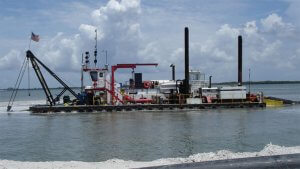
Photo ©U.S. Army Corps.
Ship channel managers regularly have to schedule maintenance and dredging activities in order to keep channels clear from sand, debris, and trash. Delays in dredging can trigger increased risks, the need for repeated maintenance and lost revenue. A new Dredging Planning Optimization Model (DPOM) decision-support tool can help asset owners make more informed dredging and maintenance decisions.
Variables, such as the volume of debris expected, availability of nearby confined disposal facilities, project grouping phases, how costs can be affected by interest rates and inflation, and local professional input, all have to be weighed before deciding to dredge navigational channels.
All ship channels must be regularly cleared, and the million-dollar question is, how can asset managers schedule dredging activities in the most timely, cost effective, and efficient manner?
A recent study supported by the New Jersey Department of Transportation Office of Maritime Resources and led by researchers at the Rutgers Center for Advanced Infrastructure and Transportation (CAIT), developed a Dredging Planning Optimization Model that can help asset owners better weigh these critical variables during maintenance planning.
The results were published in Transportation Research Part E: Logistics and Transportation Review.
The Dredging Planning Optimization Model (DPOM) can optimize channel dredging planning in confined disposal facilities by weighing variables such as channel linkage and dependency, channel bundling, accessibility and capacity, shoaling and navigability deterioration over time, reimbursable costs, channel economic values, and more.
The research team also developed a dynamic prioritization planning (DPP) algorithm that incorporates a dynamic ranking criterion to overcome the challenge of weighing these variables while also considering the impact of channel prioritization on future year decisions.
Read the full story here.

